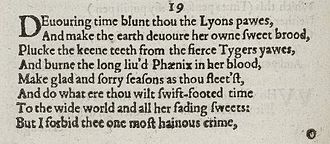Sonnet 19
Q1
Q2
Q3
C
Devouring Time, blunt thou the lion’s paws,
And make the earth devour her own sweet brood;
Pluck the keen teeth from the fierce tiger’s jaws,
And burn the long-liv’d phœnix in her blood;
Make glad and sorry seasons as thou fleets,
And do whate’er thou wilt, swift-footed Time,
To the wide world and all her fading sweets;
But I forbid thee one most heinous crime:
O, carve not with thy hours my love’s fair brow,
Nor draw no lines there with thine antique pen;
Him in thy course untainted do allow
For beauty’s pattern to succeeding men.
Yet do thy worst, old Time: despite thy wrong,
My love shall in my verse ever live young.
4
8
12
14
Sonnet 19 is one of 154 sonnets written by the English playwright and poet William Shakespeare and is considered by some to be the final sonnet of the initial procreation sequence. The sonnet addresses time directly with the instruction to destroy its own weapons and to leave Shakespeare's beloved, the fair youth, unscathed. The theme is redemption, through art, of time's inevitable decay.
Sonnet 19 is a typical English or Shakespearean sonnet. The English sonnet consists of three quatrains followed by a couplet. It follows the form's typical rhyme scheme: abab cdcd efef gg. Like all but one of Shakespeare's sonnets, Sonnet 19 is written in a type of metre called iambic pentameter based on five pairs of metrically weak/strong syllabic positions. The eighth line exemplifies a regular iambic pentameter:
Both the first and third lines exhibit reversals which thrust extra emphasis on an action verb, a practice Marina Tarlinskaja calls rhythmical italics (line three also exhibits an ictus moved to the right, resulting in a four-position figure, × × / /, sometimes referred to as a minor ionic):
Sonnet 19 addresses time directly as "Devouring Time", a translation of the often-used phrase from Ovid, "tempus edax" ().G. Wilson Knight notes and analyzes the way in which devouring time is developed by trope in the first 19 sonnets.Jonathan Hart notes the reliance of Shakespeare's treatment on tropes from not only Ovid but also Edmund Spenser.
...
Wikipedia

